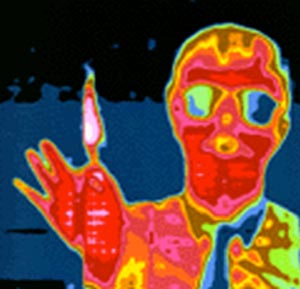Motion sensors are found everywhere today. This technology has helped accommodate our busy schedules by making our daily activities more efficient and convenient. These sensors were introduced by the demand for detection of enemy aircraft during World War II and were ultimately developed to apply to everyday life. With the demand of useful tools to make our lives more expedient, motion sensors were developed in areas such as public restrooms, grocery store doors, and security systems. This technology will continue to grow and contribute to the modern age, and will one day be found everywhere from fully automated restrooms to inside human bones.
Introduction
When shopping at a local store, I noticed that there were two sets of exit doors — one was automatic and the other manual. As I was exiting, I chose the automatic door without even thinking about it, as did many other people. When faced with an automatic door and a manual door, which one do you choose? It is a sign of the times that people prefer an automatic door to a manual one; the convenience that technology has to offer has changed the way we think and act (see Fig. 1). In this modern age, we are becoming more dependent on and accustomed to automatic features. But what makes these automatic features work? How can we expect doors to just open for us? The answer has to do with motion sensors. This article will discuss two types of motion sensors that people may experience every day but often overlook: radar and infrared.
A Brief History
The increased demand for detection and monitoring during World War II generated technological advances in motion sensing. Radar, which had been invented decades earlier but had not yet been fully developed, was now being used to counter the advantage provided by aircraft by enabling its detection [1]. Although the development of radar systems was a great achievement, its applications were limited to military use. One of the first applications of motion sensing outside the military was developed by Samuel Bagno in the mid 1940s. Using his knowledge of radar and newly developed electrical components, Bagno began doing research on an ultrasonic alarm, which worked similarly to radar. His ultrasonic alarm created “a web of ultrasonic waves inside a room” and detected the motion of a person [2]. The detector “spins its web by establishing a pattern in the way that waves bounce off inanimate objects in the room and return to a receiver.” Movement shifts created disturbances in the pattern and triggered an alarm. The invention of the ultrasonic alarm generated a demand for other non-military applications of this technology, especially infrared technology. Although infrared detection had been invented in the mid 1800s, its applications were limited to astronomy [3]. Around the same time that the ultrasonic sensors were being developed, new materials used for infrared sensing were being researched and applied [4]. Both radar and infrared motion sensing are widely used today.
Motion Sensors and How They Work
Radar Sensors
Radar sensors are much like the sensors used by Bango’s ultrasonic alarm system. They work by “radiating electromagnetic energy and detecting the echo returned from reflecting objects” [5]. The electromagnetic energy, which is in wave-form, is sent into the environment by a transmitter. Once the waves reach an object, they reflect off the object and are sent back in the opposite direction; this is known as an echo. A receiver is then used to collect the data from the echo and can assess whether a change has been made to the environment [5] Radar sensors are known as active sensors because they emit energy in order to detect a change [6].
Unlike radar sensors, infrared sensors are passive; this means that instead of having to emit energy to detect changes, they are capable of detecting radiation emitted by other objects, such as thermal energy from human beings [6] (see Fig. 2). Infrared sensors are made from different materials that sense different ranges of infrared wavelengths. When an appropriate wavelength of infrared radiation strikes one of the material’s cells, it changes the cell’s resistance. By measuring the resistance of the cell, one can measure its infrared radiation [7]. Since many different objects, both living and inert, emit a certain level of infrared radiation, it is convenient for the sensors to detect rapid changes in infrared radiation instead of a particular wavelength [8]. This way, a human being can still be detected through the slow change in atmospheric temperature. When a sensor detects a rapid change, a device is triggered to either start or stop working. One example is a motion sensor porch light, in which the sensor detects a sudden change in infrared radiation and triggers the light to turn on.
Motion Sensors in Everyday Life
Both radar and infrared sensors are used all around us in places we might not realize: public restrooms, shopping centers, and building alarm systems are among these.
You may have noticed many new public bathrooms are switching to touch-free or automatic flushers, faucets, and hand-dryers. This is only possible with the use of motion sensors. Most of the motion sensors used in public restrooms today are infrared [9]. The faucets and hand dryers are activated once a change in infrared radiation is detected [10]. The flushers work by sensing a person approaching and departing, and then producing signals that correspond to both. These signals can be used to determine the correct time to flush [11]. Touch-free systems in public restrooms are growing in popularity because, after all, restrooms are not a place most people would want to be in contact with. How many times have you seen someone open the door with their elbows after washing their hands?
Shopping Centers
As mentioned in the introduction, motion sensors are also common in places such as the entrance and exit doors of grocery stores. Most of these sensors use radar and send out a high frequency sound wave and “listen” for bounce-back. If the sound wave returns at a different frequency, the sensor knows there is a moving object within the detection zone and sends a signal to open the door (Bircher Reglomat). Automatic doors are not only convenient because they provide easy access into a building, but they are also safer: the handicapped, elderly, or anyone carrying packages or heavy items can enter and exit much more safely using automatic doors [12].
Building and Home Alarm Systems
Another application of motion sensors that one might experience every day is the alarm systems in most buildings and in some homes. Both types of sensors, radar and passive infrared, have been commonly and effectively used for motion detection in alarms [2];[13] However, passive infrared systems have been used more recently in alarms, since the sensitivity of the sensor can be set to the temperature of the human body [6]. With this sensitivity, the number of false alarms is reduced since the sensor does not simply detect motion like radar sensors [2]. Both radar and infrared sensors can be connected to a sound alarm and cameras that will only turn on when the sensor has detected a change in the room [14]. Motion sensors in security alarms are very effective and are essential for most businesses. With motion sensors, a whole building can be monitored simultaneously.
Flood and Porch Lights
Motion sensors are also commonly used with flood lights and porch lights. Most of these systems use passive infrared sensors, like the alarm systems, and are often connected to a timer [8]. There are various reasons to have motion sensor lights; they act as a deterrent for criminal behavior, are energy efficient in case you have kids that refuse to turn the lights off, and offer the reassurance that you will never be left stranded in the darkness fiddling with the keys to unlock the front door [15].
The Future of Motion Sensors
Motion sensors are all around us and have assisted in making our lives more convenient and efficient. With the further development of technology designed to interact with motion sensing systems, more applications will arise and this technology will become more common in our everyday lives.
Although some of the basic applications of motion sensors have been described here, the use of motion sensors is not limited to restrooms and alarm systems. With the development of Micro Electrical Mechanical Systems, or MEMS, it is possible to make micro motion sensors that are lightweight and affordable. It is possible that we will see these sensors worn or even sewn into clothes in which athletes could examine their performance more closely or allow nurses working at a distance to monitor elderly people in their homes. It is even possible that motion sensors will be implanted into bones during surgeries, allowing doctors to monitor the progress of repairs [16]. Just as we have grown accustomed to the automatic doors in grocery stores, we will continue to rely on modern motion sensors to make our everyday activities more convenient and efficient.





